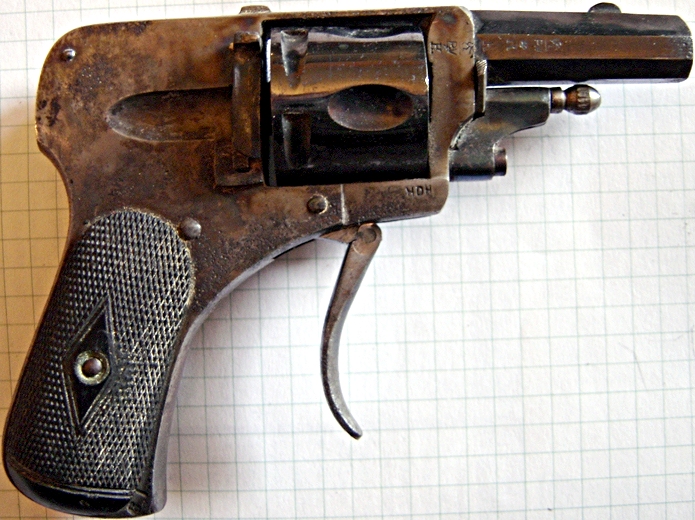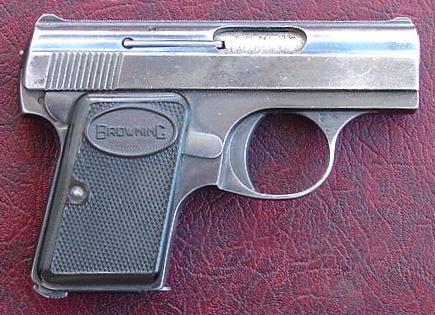|
Velo-dog
The Velo-Dog (also known as a ''Revolver de Poche'') was a pocket pistol, pocket revolver originally created in France by René Galand, son of Charles-François Galand in the late 19th century as a defense for cyclists against dog attacks. The name is a compound word composed of "velocipede" and "dog". Surviving examples vary considerably in appearance, but have certain features in common. The hammer is shrouded to avoid its snagging on clothing, so the weapon is Revolver#Double-action, double action only. All have short barrels and originally fired the 5.75 mm (.22 calibre) Velo-dog cartridge, although many of the Velo-Dogs produced after 1900 accepted .22 LR or .25 ACP rounds. Another feature on many late models Velo-Dogs is the lack of a trigger guard, and a trigger that folds into the body of the weapon when not in use. For the more humane, there were cartridges loaded with cayenne pepper or dust, or which had bullets made from wax, wood or cork. The original revolver ... [...More Info...] [...Related Items...] OR: [Wikipedia] [Google] [Baidu] |
Charles-François Galand
Charles-François Galand (1832–1900) was a French gunsmith who worked in Liège, Belgium, and Paris, France. He manufactured many revolvers for civilian and military use, including the Galand Revolver (also called the Galand-Sommerville or Galand-Perrin), the Tue Tue, and the tiny Le Novo. The Velo-dog, developed from the Tue Tue and the Novo, was designed by Charles-François' son René in 1904. The original Galand revolver was a double-action, open frame (no strap across the top of the cylinder) revolver patented in 1868. Military versions were produced in 9 mm while civilian versions were made in 12 mm. The gun is easily recognizable due to its long extraction lever, which stretches under the gun to form the trigger guard. Pulling the lever forward separates the barrel and cylinder from the rest of the gun. At the same time the extractor plate is blocked which catches any cartridges in the cylinder, thereby extracting them. The first model was manufactured ... [...More Info...] [...Related Items...] OR: [Wikipedia] [Google] [Baidu] |
Bossu Revolver
The Bossu Revolver was a Velo-dog revolver of Belgian origin. Manufacture d’armes Lepage Lepage or LePage or Le Page is a surname that may refer to: * Antoine-Simon Le Page du Pratz (1695?–1775), author of a memoir about early 18th century Louisiana * Bradford William LePage (1876–1958), Canadian politician * Corinne Lepage (born ... produced one, as did HDH. References ;Notes ;Sources * Revolvers of Belgium {{revolver-stub ... [...More Info...] [...Related Items...] OR: [Wikipedia] [Google] [Baidu] |
Pocket Pistol
In American English, a pocket pistol is any small, pocket-sized semi-automatic pistol (or less commonly referencing either derringers, or small revolvers), and is suitable for concealed carry in either a coat, jacket, or trouser pocket. Pocket pistols are sometimes categorized as smaller than sub-compact pistols, but the distinction is not clear-cut as some small sub-compact pistols may be categorized as pocket pistols, and some large pocket pistols may be classified as sub-compact pistols. Pocket pistols were popular in the United States until the 1960s and 1970s when most states passed laws limiting or prohibiting the carry of concealed weapons. However, the passage of "shall issue" firearms license laws in the 1980s and 1990s resulted in a resurgence in the popularity of pocket pistols in the United States, creating new markets for small, simple, reliable, concealed-carry firearms. In general use, the term pocket pistol is purely descriptive, but "mouse gun" (used especiall ... [...More Info...] [...Related Items...] OR: [Wikipedia] [Google] [Baidu] |
Galand Velo-dog
Galand ( fa, گلند; also known as Findarisk and Garland) is a village in Daland Rural District, in the Central District of Ramian County, Golestan Province, Iran Iran, officially the Islamic Republic of Iran, and also called Persia, is a country located in Western Asia. It is bordered by Iraq and Turkey to the west, by Azerbaijan and Armenia to the northwest, by the Caspian Sea and Turkmeni .... At the 2006 census, its population was 2,485, in 571 families. References Populated places in Ramian County {{Ramian-geo-stub ... [...More Info...] [...Related Items...] OR: [Wikipedia] [Google] [Baidu] |
Early Revolvers
{{disambiguation, geo ...
Early may refer to: History * The beginning or oldest part of a defined historical period, as opposed to middle or late periods, e.g.: ** Early Christianity ** Early modern Europe Places in the United States * Early, Iowa * Early, Texas * Early Branch, a stream in Missouri * Early County, Georgia Other uses * ''Early'' (Scritti Politti album), 2005 * ''Early'' (A Certain Ratio album), 2002 * Early (name) * Early effect, an effect in transistor physics * Early Records, a record label * the early part of the morning See also * Earley (other) Earley is a town in England. Earley may also refer to: * Earley (surname), a list of people with the surname Earley * Earley (given name), a variant of the given name Earlene * Earley Lake, a lake in Minnesota *Earley parser, an algorithm *Earley ... [...More Info...] [...Related Items...] OR: [Wikipedia] [Google] [Baidu] |
Revolvers
A revolver (also called a wheel gun) is a repeating handgun that has at least one barrel and uses a revolving cylinder containing multiple chambers (each holding a single cartridge) for firing. Because most revolver models hold up to six rounds of cartridge before needing to reload, revolvers are also commonly called six shooters. Before firing, cocking the revolver's hammer partially rotates the cylinder, indexing one of the cylinder chambers into alignment with the barrel, allowing the bullet to be fired through the bore. The hammer cocking in nearly all revolvers are manually driven, and can be achieved either by the user using the thumb to directly pull back the hammer (as in single-action), via internal linkage relaying the force of the trigger-pull (as in double-action), or both (as in double/single-action). By sequentially rotating through each chamber, the revolver allows the user to fire multiple times until having to reload the gun, unlike older single-shot fire ... [...More Info...] [...Related Items...] OR: [Wikipedia] [Google] [Baidu] |
Revolvers Of France
A revolver (also called a wheel gun) is a repeating firearm, repeating handgun that has at least one gun barrel, barrel and uses a revolving cylinder (firearms), cylinder containing multiple chamber (firearms), chambers (each holding a single cartridge (firearms), cartridge) for firing. Because most revolver models hold up to six rounds of cartridge before needing to reload, revolvers are also commonly called six shooters. Before firing, cocking the revolver's hammer (firearms), hammer partially rotates the cylinder, indexing (motion), indexing one of the cylinder chambers into alignment with the barrel, allowing the bullet to be fired through the bore. The hammer cocking in nearly all revolvers are manually driven, and can be achieved either by the user using the thumb to directly pull back the hammer (as in trigger (firearms)#Single-action, single-action), via internal linkage (mechanical), linkage relaying the force of the trigger-pull (as in trigger (firearms)#Double-actio ... [...More Info...] [...Related Items...] OR: [Wikipedia] [Google] [Baidu] |
Erast Fandorin
Erast Petrovich Fandorin (russian: Эраст Петрович Фандорин) is a fictional 19th-century Russian detective and the hero of a series of Russian historical detective novels by Boris Akunin. The first Fandorin novel (''The Winter Queen'', Russian: ''Азазель'') was published in Russia in 1998, and the latest and the last one in 2018 (''Not Saying Goodbye'', Russian: ''Не прощаюсь''). More than 15 million copies of Fandorin novels have been sold as of May 2006, even though the novels were freely available from many Russian websites and the hard copies were relatively expensive by Russian standards.Leon Aron, "''A Private Hero for a Privatized Country''" in ''Russian Outlook'' , retrieved 17 August 2006. New books in the Fandorin ... [...More Info...] [...Related Items...] OR: [Wikipedia] [Google] [Baidu] |
Boris Akunin
Boris Akunin (russian: Борис Акунин) is the pen name of Grigori Chkhartishvili (russian: Григорий Шалвович Чхартишвили, Grigory Shalvovich Chkhartishvili; ka, გრიგორი ჩხარტიშვილი, born 20 May 1956), a Russian-Georgian writer. He is best known as writer of detective and historical fiction. He is also an essayist and literary translator. Grigory Chkhartishvili has also written under pen names Anatoly Brusnikin, Anna Borisova, and Akunin-Chkhartishvili. His characters include Erast Fandorin, Nicholas Fandorin and Sister Pelagia. Life and career Chkhartishvili was born in Zestaponi to a Georgian father and a Jewish mother and lived in Moscow from 1958 until 2014. Since then he has lived between Britain, France and Spain. Influenced by Japanese Kabuki theatre, he joined the historical-philological branch of the Institute of Asian and African Countries of Moscow State University as an expert on Japan. He was e ... [...More Info...] [...Related Items...] OR: [Wikipedia] [Google] [Baidu] |
The Death Of Achilles
The Death of Achilles (russian: Смерть Ахиллеса) is the fourth novel in the Erast Fandorin historical detective series by Boris Akunin. Its subtitle is ''детектив о наемном убийце'' ("a detective novel about a murderer-for-hire"). It was originally published in Russian in 1998; the English translation was released in 2006. Plot Moscow, 1882. When Fandorin returns from Japan with his manservant Masa, he enters the service of Moscow governor Prince Dolgorukoi. Later that day, the White General Mikhail Sobolev, nicknamed the Russian Achilles and an old friend of Fandorin's, is found dead in the same hotel. Officially, he died of a heart attack, but Fandorin becomes suspicious when he talks with the body guards of the general. Fandorin had befriended these cossacks when he rooted out a Turkish spy during the siege of Plevna (see ''The Turkish Gambit''). But the same cossacks now treat him with hostility. Fandorin finds out the reason for thei ... [...More Info...] [...Related Items...] OR: [Wikipedia] [Google] [Baidu] |
22 Long Rifle
The .22 Long Rifle or simply .22 LR or 22 (metric designation: 5.6×15mmR) is a long-established variety of .22 caliber rimfire ammunition originating from the United States. It is used in a wide range of rifles, pistols, revolvers, smoothbore shotguns, and submachine guns. In terms of units sold it is by far the most common ammunition in the world today. Common uses include hunting and shooting sports. Ammunition produced in .22 Long Rifle is effective at short ranges, has little recoil, and is cheap to purchase, making it ideal for training. History American firearms manufacturer J. Stevens Arms & Tool Company introduced the .22 Long Rifle cartridge in 1887. The round owes its origin to the .22 BB Cap of 1845 and the .22 Short of 1857. It combined the case of the .22 Long of 1871 with a bullet, giving it a longer overall length, a higher muzzle velocity and superior performance as a hunting and target round, rendering the .22 Extra Long cartridges obsolete. The .22 LR ... [...More Info...] [...Related Items...] OR: [Wikipedia] [Google] [Baidu] |
Fiocchi
Fiocchi Munizioni (Fiocchi Ammunition) is one of Italy's largest and oldest manufacturers of ammunition. The company's headquarters and main production plant are in Via Santa Barbara in Lecco, Italy. History Fiocchi Munizioni was founded on 3 July 1876 in Lecco, Italy, by accountant Giulio Fiocchi. In 1876, Giulio Fiocchi took over the ammunition production part of a weapon and ammunition company already based in Lecco, which produced small-caliber ammunition. At that time a radical change was introduced in firearms: the newly developed breech-loader replaced the traditional muzzle loader. Fiocchi started manufacturing cases with primers suitable for reloading; in the early 1890s production was extended to complete cartridges loaded with bullets or shot. At the same time, Fiocchi gave up the production of black powder, as it was no longer profitable. At the beginning of the 20th century, Fiocchi diversified and began making snap fasteners using scraps from cartridge produc ... [...More Info...] [...Related Items...] OR: [Wikipedia] [Google] [Baidu] |




